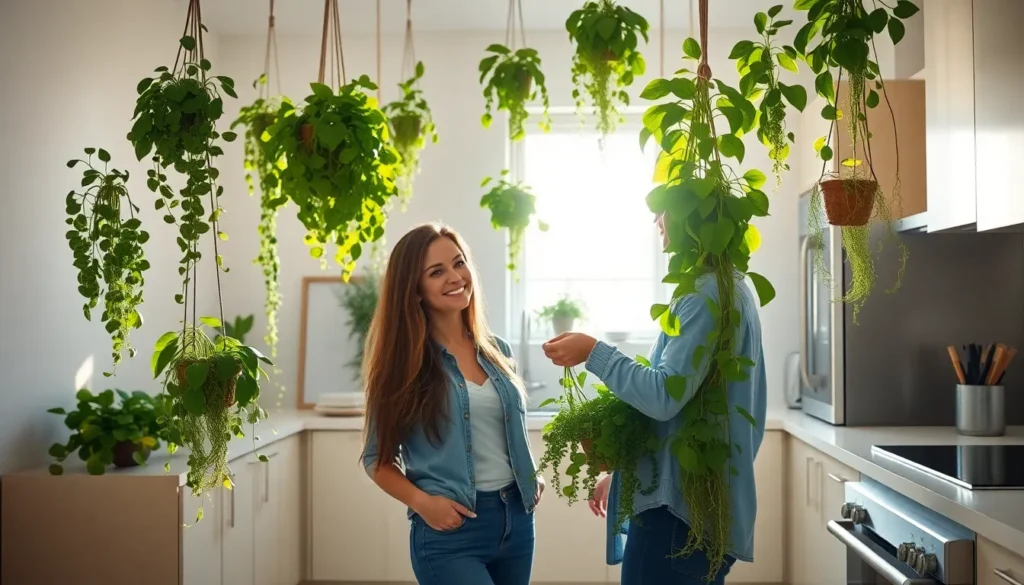We’ve all dreamed of that perfect kitchen where fresh herbs dangle gracefully above our cooking space and lush greenery transforms our culinary haven into a living, breathing sanctuary. Hanging plants in the kitchen aren’t just Instagram-worthy décor – they’re practical answers that maximize space while purifying the air we breathe as we cook.
Whether you’re working with a compact apartment kitchen or a spacious culinary paradise, vertical gardening opens up endless possibilities. From trailing pothos that cascade beautifully from ceiling hooks to aromatic herb gardens suspended near your prep station, hanging plants create visual interest while keeping your countertops clutter-free.
We’ll explore how to choose the right plants for your kitchen’s unique conditions, master the art of proper placement, and discover creative hanging answers that’ll make your friends wonder how you became such a green-thumb genius. Your kitchen’s about to become the most enviable room in your home.
Choose the Perfect Hanging Plants for Your Kitchen Environment
Selecting the right hanging plants for your kitchen requires understanding your exact growing conditions and space limitations. We’ll guide you through the best plant categories that thrive in typical kitchen environments.
Low-Light Tolerant Varieties
Pothos plants excel in kitchens with limited natural light, making them our top recommendation for darker spaces. These trailing beauties adapt to fluorescent lighting and can grow up to 10 feet long when properly maintained. We’ve found that golden pothos and marble queen varieties perform exceptionally well near kitchen windows that receive only 2-4 hours of indirect sunlight daily.
ZZ plants (Zamioculcas zamiifolia) offer glossy, architectural foliage that tolerates neglect and low light conditions. Their compact upright growth reaches 2-3 feet, making them perfect for hanging baskets positioned away from windows. We recommend these for kitchens with north-facing windows or areas illuminated primarily by artificial lighting.
Snake plants provide striking vertical interest while requiring minimal light maintenance. These succulent varieties can survive in areas receiving as little as 50-100 foot-candles of light. We suggest choosing smaller cultivars like ‘Hahnii’ or ‘Twisted Sister’ for hanging applications.
Humidity-Loving Species
Boston ferns thrive in the naturally humid kitchen environment created by cooking steam and running water. These lush plants prefer humidity levels between 40-50%, which most kitchens naturally provide. We’ve observed that kitchens with dishwashers and frequent cooking activities create ideal conditions for these feathery specimens.
Air plants (Tillandsia species) absorb moisture directly from kitchen air, eliminating the need for traditional watering. These epiphytes flourish in spaces with 50-60% humidity and benefit from the steam generated during meal preparation. We recommend misting them 2-3 times weekly plus to the ambient kitchen moisture.
Prayer plants (Maranta leuconeura) showcase stunning patterned foliage that responds to kitchen humidity fluctuations. Their leaves fold upward at night, creating an interactive display that changes throughout the day. We’ve found these plants perform best when positioned 3-4 feet from cooking areas to receive optimal humidity without heat stress.
Compact Growth Options
String of hearts produces delicate trailing stems that won’t overwhelm small kitchen spaces. This succulent vine grows 2-4 inches per month and creates an elegant cascading effect from hanging baskets. We recommend these for kitchens where space is limited but visual impact is desired.
Baby spider plants offer the classic spider plant appeal in a more manageable size. These compact versions reach 6-8 inches in height and produce smaller plantlets that won’t crowd your kitchen area. We suggest positioning them in corners or over kitchen islands where their trailing babies can be appreciated.
Compact English ivy varieties provide year-round greenery while maintaining controlled growth patterns. Cultivars like ‘Needlepoint’ and ‘Duck Foot’ stay under 12 inches and create dense, lush hanging displays. We’ve found these particularly suitable for kitchens where consistent, neat appearance is prioritized over dramatic trailing effects.
Select Strategic Locations for Maximum Impact
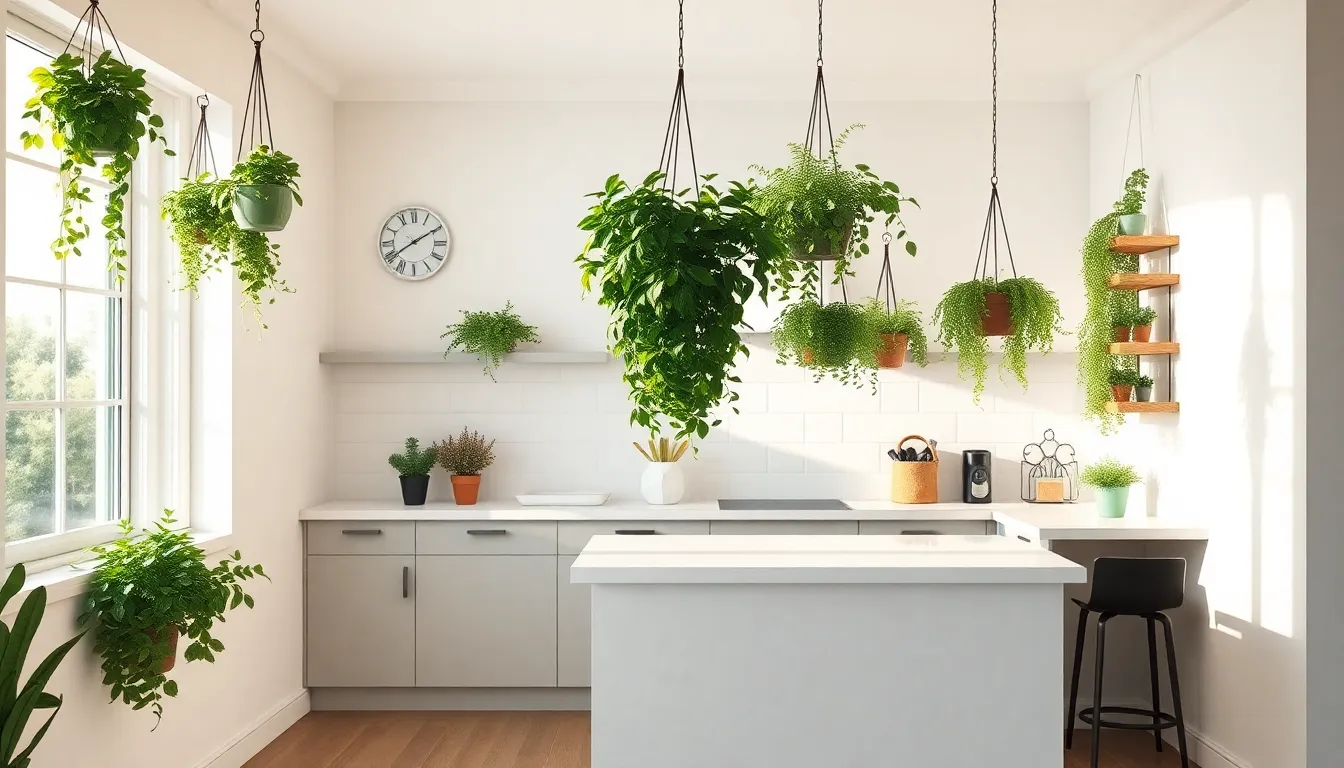
Now that we’ve chosen our plants, let’s position them strategically to maximize their visual appeal and health benefits.
Near Windows for Natural Light
Windows provide the essential sunlight our hanging plants need for photosynthesis and optimal growth. We’ll find that positioning plants near kitchen windows ensures they receive sufficient natural light while improving their air-purifying effects as they absorb carbon dioxide and release fresh oxygen. Kitchen windows work particularly well for herbs like basil and parsley, combining beautiful decoration with functional ingredients we can harvest during cooking.
Sunlight exposure helps our plants thrive and significantly improves indoor air quality throughout our kitchen space. We should consider the direction our windows face when selecting plant varieties, as south-facing windows offer the most intense light while north-facing ones provide gentler illumination.
Above Kitchen Islands and Counters
Kitchen islands and counters create perfect opportunities for dramatic hanging displays that transform our cooking space into a green oasis. We can suspend plants above these areas to establish striking visual focal points without sacrificing valuable workspace below. This placement utilizes our vertical space effectively, which becomes especially important in kitchens where counter real estate is limited.
Different planter styles like macramé hangers or sleek modern pots can complement our existing kitchen design while keeping plants easily accessible for watering and care. We’ll discover that this elevated positioning creates an inviting and calming ambiance that makes our kitchen more enjoyable for both cooking and entertaining guests.
Corner Spaces and Empty Walls
Corners and bare wall areas often remain underutilized in our kitchen layouts, presenting excellent opportunities for creative plant placement. We can transform these empty spaces by installing hanging planters or creating vertical gardens that add texture and natural life to our environment. Wall-mounted hanging systems work exceptionally well for herb gardens, giving us fresh ingredients within arm’s reach while optimizing every inch of available space.
This strategic placement approach adds visual depth and dimension to our kitchen while contributing to a lush, natural atmosphere that feels both sophisticated and welcoming. We’ll find that filling these previously empty areas creates a more cohesive design that brings our entire kitchen together with living greenery.
Install Proper Hanging Systems and Hardware
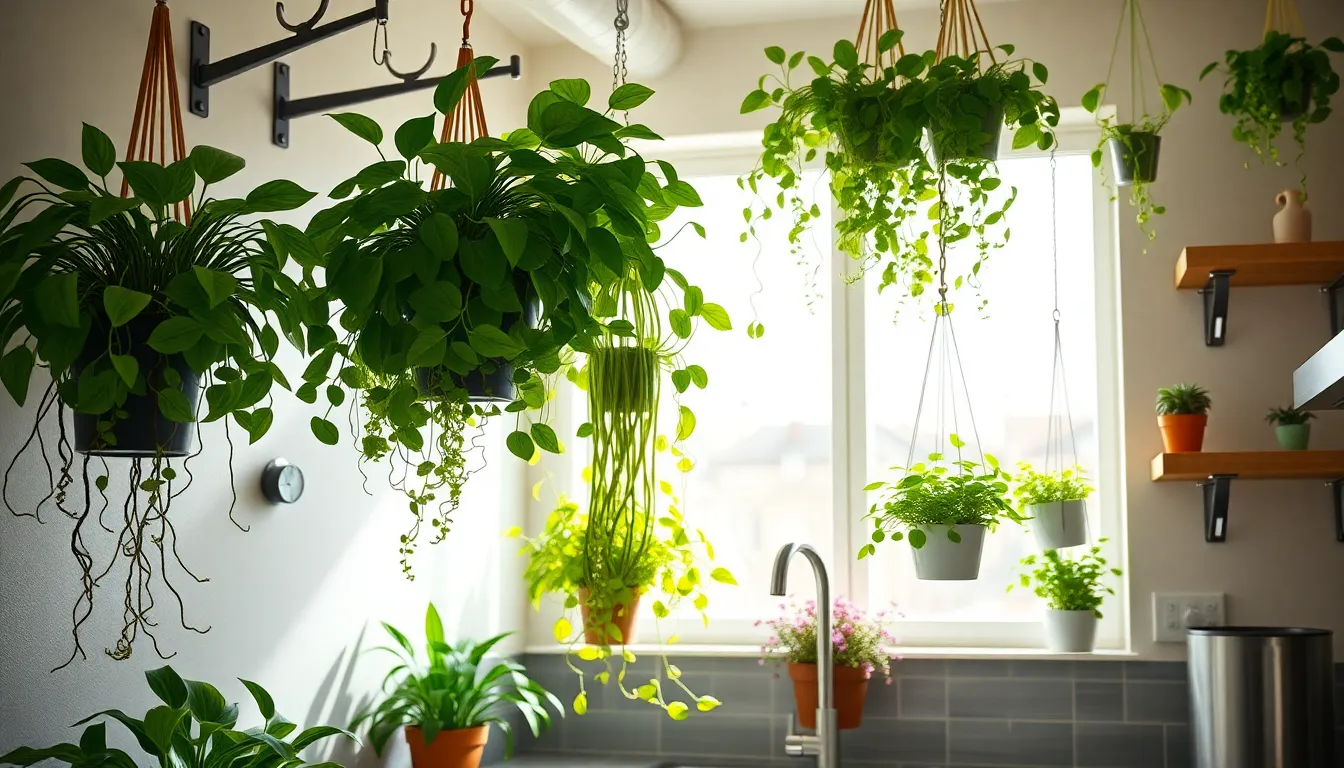
Once you’ve selected your plants and identified the perfect spots, we need to ensure they’re securely supported with the right hardware. The safety of your hanging garden depends entirely on choosing appropriate mounting systems that can handle your plants’ weight and growth over time.
Ceiling Hooks and Mounting Options
Ceiling hooks provide the most versatile hanging solution for kitchen plants, offering excellent weight capacity when properly installed. We recommend using swag hooks with toggle bolts for drywall ceilings, as they can securely hold 15 to 20 pounds per hook. This installation requires drilling a 5/8 inch hole, inserting the toggle bolt through the hook, and tightening until it’s flush against the ceiling.
For maximum strength, we always prefer installing hook screws directly into ceiling joists after locating them with a stud finder. This method can support over 30 pounds and provides the most reliable long term solution for heavier plant arrangements. Always drill a pilot hole that’s slightly smaller than the screw shaft to ensure a tight, secure fit.
Testing your hook’s strength before hanging plants is essential for safety. We suggest gently pulling on the installed hook with similar weight to your planned plant to verify it’s properly secured.
Wall-Mounted Brackets and Shelves
Wall-mounted brackets offer excellent alternatives when ceiling installation isn’t practical or desired in your kitchen space. These fixtures allow us to display plants at eye level or above counters, creating easy access for watering while adding greenery without sacrificing valuable counter space.
Floating shelves designed for plants can transform empty wall areas into stunning vertical gardens. We recommend securing all wall brackets directly into wall studs whenever possible, as this provides the strongest foundation for your hanging plant display.
For lighter plants weighing less than 10 pounds, heavy duty wall anchors can provide adequate support in drywall applications. Always match your hardware’s weight capacity to exceed your plant’s total weight, including soil and water.
Tension Rod Answers
Tension rods installed between two walls near the ceiling offer perfect answers for renters or anyone avoiding permanent modifications. We can hang plants from S-hooks attached directly to these rods, creating flexible arrangements that accommodate multiple plants.
Weight capacities for tension rod systems typically range from 10 to 30 pounds total, making them suitable for lighter plant collections. This method allows us to easily rearrange plants or remove them entirely without leaving any wall damage.
For optimal stability, we recommend choosing tension rods with rubber end caps and adjustable spring mechanisms. Position the rod as close to the ceiling as possible to maximize hanging space while ensuring it’s level and properly tensioned between walls.
Consider Lighting Requirements for Kitchen Plants
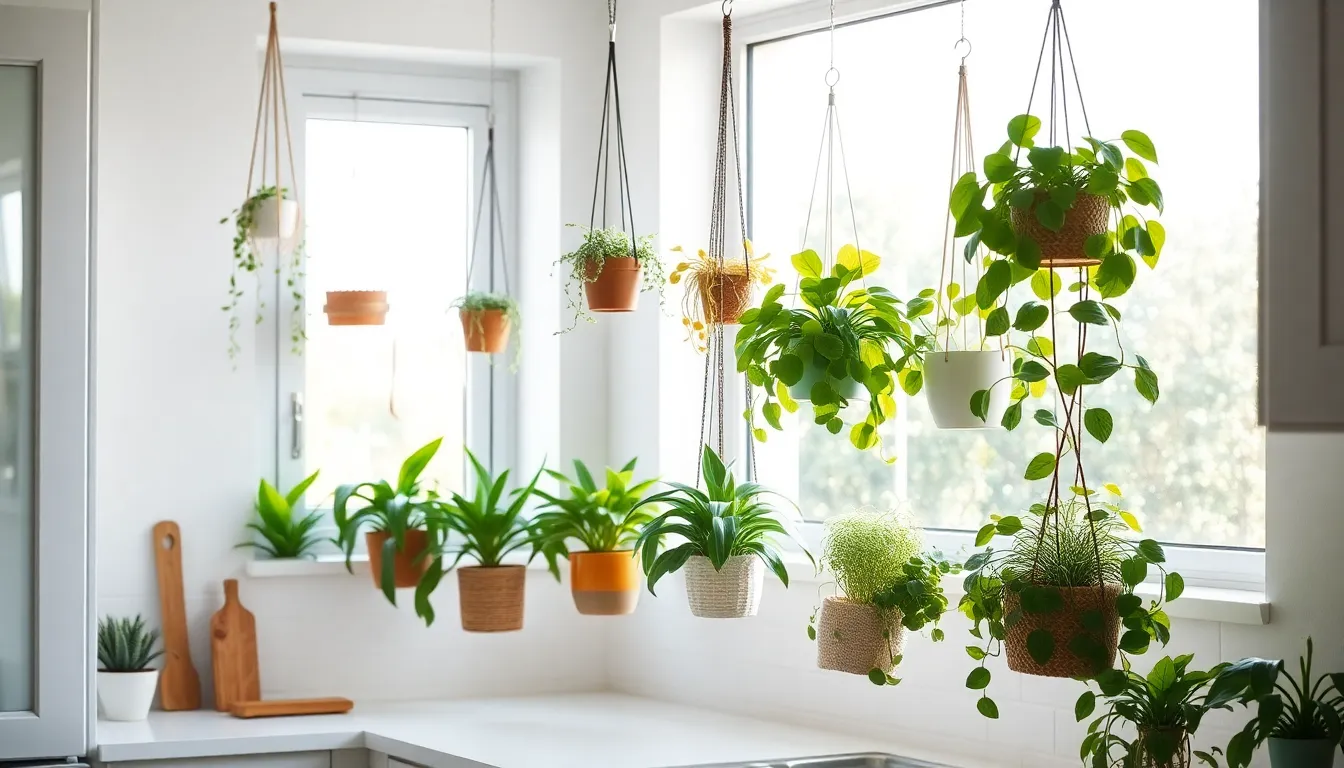
Lighting forms the foundation of successful kitchen plant care. We’ll explore how to evaluate your space’s natural illumination and supplement it effectively.
Natural Light Assessment
Evaluate your kitchen’s window orientation and light intensity throughout the day. Most indoor kitchen spaces receive indirect or medium light conditions. Plants thriving in medium indirect light typically perform well when positioned 6-8 feet from a window or in the center of a sunny room.
Morning sun provides gentler conditions than harsh afternoon exposure. We recommend observing how sunlight moves through your kitchen during different hours. East-facing windows offer ideal morning light that won’t burn delicate foliage. South and west-facing windows may create too intense conditions for many hanging varieties.
Document light levels in potential hanging locations. Areas near windows receive high light, while spots further away qualify as medium to low light zones. This assessment determines which plants will flourish in each exact location.
Supplemental Grow Light Options
LED grow lights offer reliable supplementation when natural light proves insufficient. These energy-efficient options can replace or enhance existing illumination. Position LED grow lights at exact distances based on your plants’ requirements:
| Plant Light Needs | Recommended Distance | Examples |
|---|---|---|
| Full sun plants | 12-24 inches | Tomatoes, melons |
| High light plants | 24-36 inches | Fiddle leaf fig, citrus trees |
| Medium light plants | 36-48 inches | Boston fern, calathea |
| Low light plants | 36-60 inches | Snake plant, pothos |
Maintain at least 12 inches distance from foliage to prevent burning. LED strips with different color spectrums support photosynthesis more effectively. Warmer colors work well during evening hours, while daylight spectrums benefit morning growth periods.
Consider timer-controlled systems for consistent lighting schedules. This automation ensures plants receive adequate daily light exposure without manual adjustments.
Rotating Plants for Even Growth
Hanging plants develop uneven growth when light comes from only one direction. Regular rotation ensures all sides receive equal light exposure. This practice prevents plants from leaning toward light sources or growing lopsided.
Establish a weekly rotation schedule for optimal results. Turn each plant a quarter turn every seven days. This simple maintenance step promotes balanced foliage development and maintains attractive, symmetrical growth patterns.
Kitchen environments with limited window access require more frequent attention. Fixed light sources create stronger directional growth tendencies. We recommend rotating these plants twice weekly to counteract uneven development.
Maintain Proper Watering and Care Routines
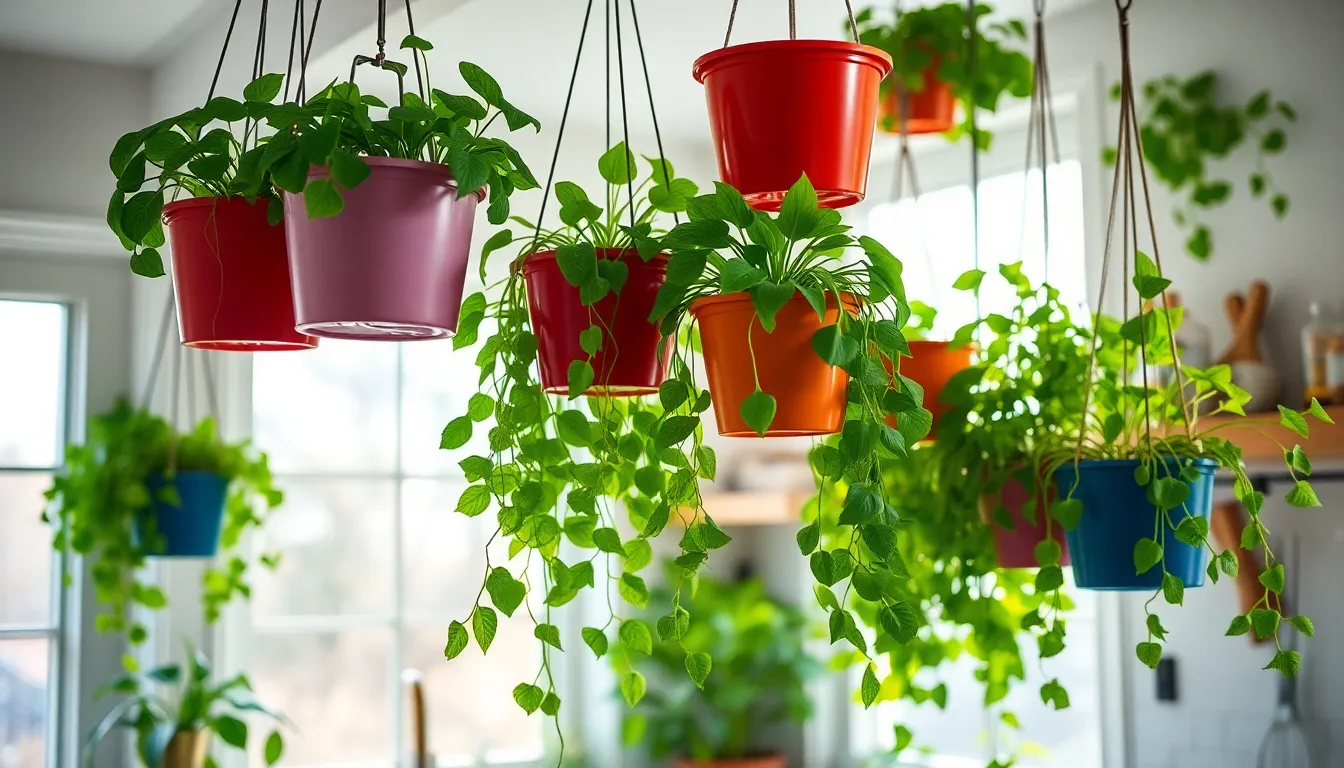
With your kitchen hanging plants now properly positioned and lit, we need to establish consistent care routines that’ll keep them thriving in this unique environment.
Drainage and Water Management
Choose hanging pots with good drainage holes to allow excess water to escape naturally. Water pooling at the bottom causes root damage and creates the perfect conditions for root rot to develop. We recommend avoiding pots that are fully closed at the bottom unless you’re prepared to check moisture levels diligently.
Check soil moisture regularly since hanging pots often lack visible drainage indicators. Insert your finger about an inch into the soil to gauge whether it’s too dry or overly wet. Good soil with a loose, airy structure helps excess water drain while keeping roots healthy and well-aerated.
Use a watering method that moistens soil evenly without creating waterlogged conditions. Pour water slowly and stop when you see it beginning to drain from the bottom holes. This technique prevents oversaturation while ensuring your plants receive adequate hydration.
Fertilizing Schedule
Apply liquid fertilizer once a week during growing season (typically March through October) since hanging plants grow in limited soil volumes. Mix the fertilizer directly into your irrigation water according to package directions for your exact plant type. Regular feeding compensates for the restricted root space that limits natural nutrient uptake.
Consider slow-release fertilizers as an alternative that reduces feeding frequency to just twice per season. These granules provide steady nutrition over several months, making maintenance easier for busy kitchen gardeners. Apply them in early spring and mid-summer for optimal plant performance.
Reduce fertilizing frequency during winter months when most plants enter dormant periods. Monthly feeding or complete cessation works best depending on your plant varieties and kitchen temperature conditions.
Pruning and Maintenance
Prune regularly to encourage healthy growth and maintain attractive plant shapes in your kitchen display. Remove dead, yellowing, or damaged leaves as soon as you notice them to prevent disease spread. Trim leggy growth that may indicate insufficient light exposure.
Clean leaves periodically to remove dust buildup that blocks light and reduces photosynthesis efficiency. Use a soft cloth or gentle water spray to wipe leaves clean, then allow plants to dry completely before rehanging them. This simple step dramatically improves your plants’ ability to process light.
Monitor for signs that indicate care adjustments such as brown leaf tips (overwatering), yellowing leaves (underwatering), or excessive stretching (inadequate light). Address these issues promptly by modifying your watering schedule or relocating plants to better positions within your kitchen space.
Design Around Your Kitchen’s Style and Layout
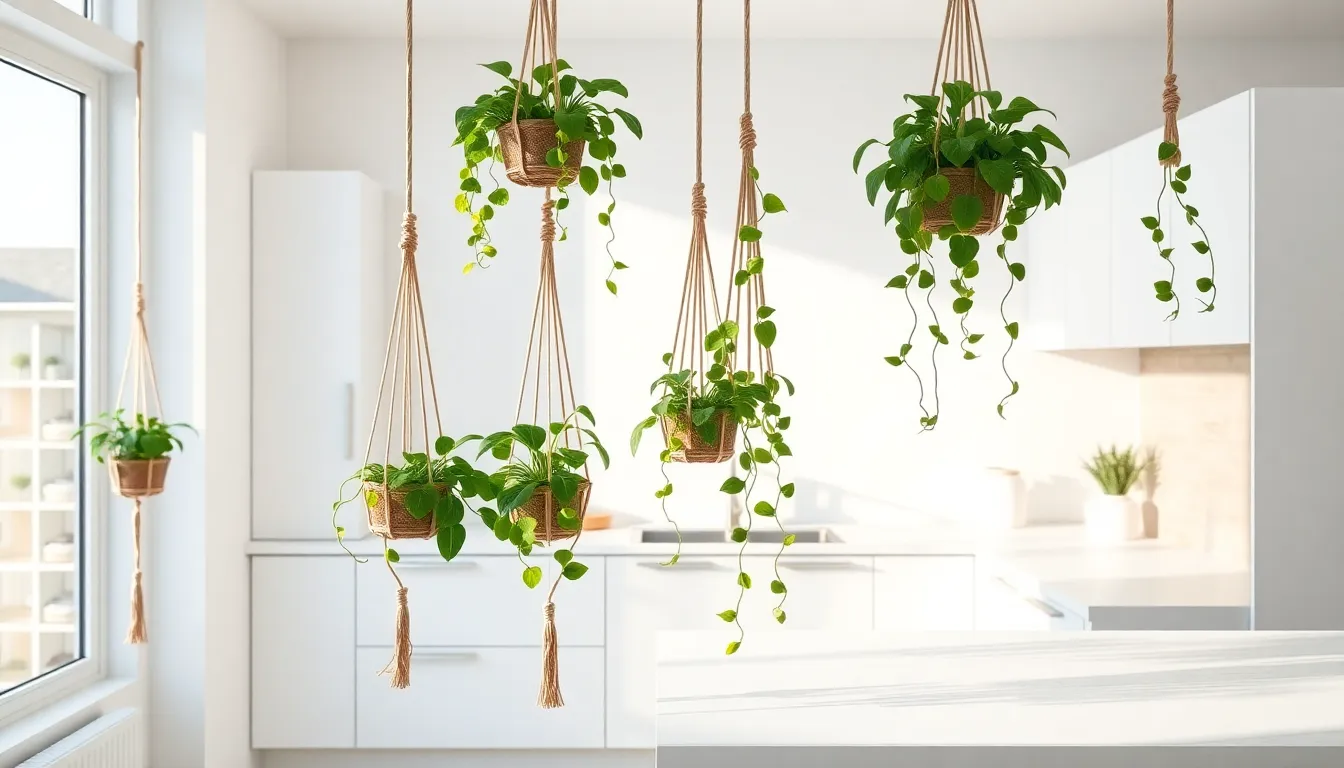
Your kitchen’s unique style and layout directly influence which hanging plant arrangements will create the most stunning visual impact. We’ll explore how different design approaches can transform your space with the perfect botanical touches.
Modern Minimalist Approaches
Sleek simplicity defines modern minimalist kitchens, where hanging plants should complement clean lines rather than compete with them. We recommend choosing plants with simple, understated forms like Philodendron cordatum, which offers elegant trailing stems without overwhelming the space’s architectural elements.
Macramé holders and curtain rods provide the perfect suspension system for this aesthetic, creating visual interest through geometric patterns while maintaining the uncluttered feel. These mounting answers allow you to position trailing plants at various heights without adding bulk to your streamlined design.
Bright indirect light works best for minimalist plant selections, making low maintenance varieties ideal for busy lifestyles. Plants that thrive in these conditions require less frequent attention, preserving the effortless sophistication that defines modern kitchen design.
Rustic and Farmhouse Aesthetics
Natural textures and earthy tones form the foundation of rustic kitchen design, making terracotta pots and wooden holders perfect for your hanging plant displays. These materials create authentic farmhouse charm while providing sturdy support for larger plant varieties.
Trailing ivy and small succulents enhance the cozy, lived in atmosphere that characterizes farmhouse style. We suggest incorporating fresh herbs like rosemary or thyme, which serve double duty as both decorative elements and practical cooking ingredients.
Exposed beams offer ideal mounting points for hanging plants, adding vertical dimension while emphasizing the rustic architectural features. Multiple plants suspended at different heights create visual layers that make your kitchen feel more spacious and inviting.
Small Kitchen Space Answers
Vertical gardening becomes essential in compact kitchens where every square inch of counter space counts. We recommend utilizing window areas, curtain rods, and wall mounts to keep plants elevated while maximizing your available work surfaces.
Succulents and trailing plants requiring minimal watering prevent moisture issues in confined spaces while adding vibrant color to tight quarters. These hardy varieties thrive even when positioned in less than ideal lighting conditions common in smaller kitchens.
Clustered arrangements of multiple small plants create greater visual impact than single large specimens while maintaining proportional balance. Strategic grouping of 3 to 5 plants in coordinating containers transforms empty corners into ever-changing focal points without overwhelming your limited space.
Avoid Common Mistakes When Hanging Plants in Kitchen
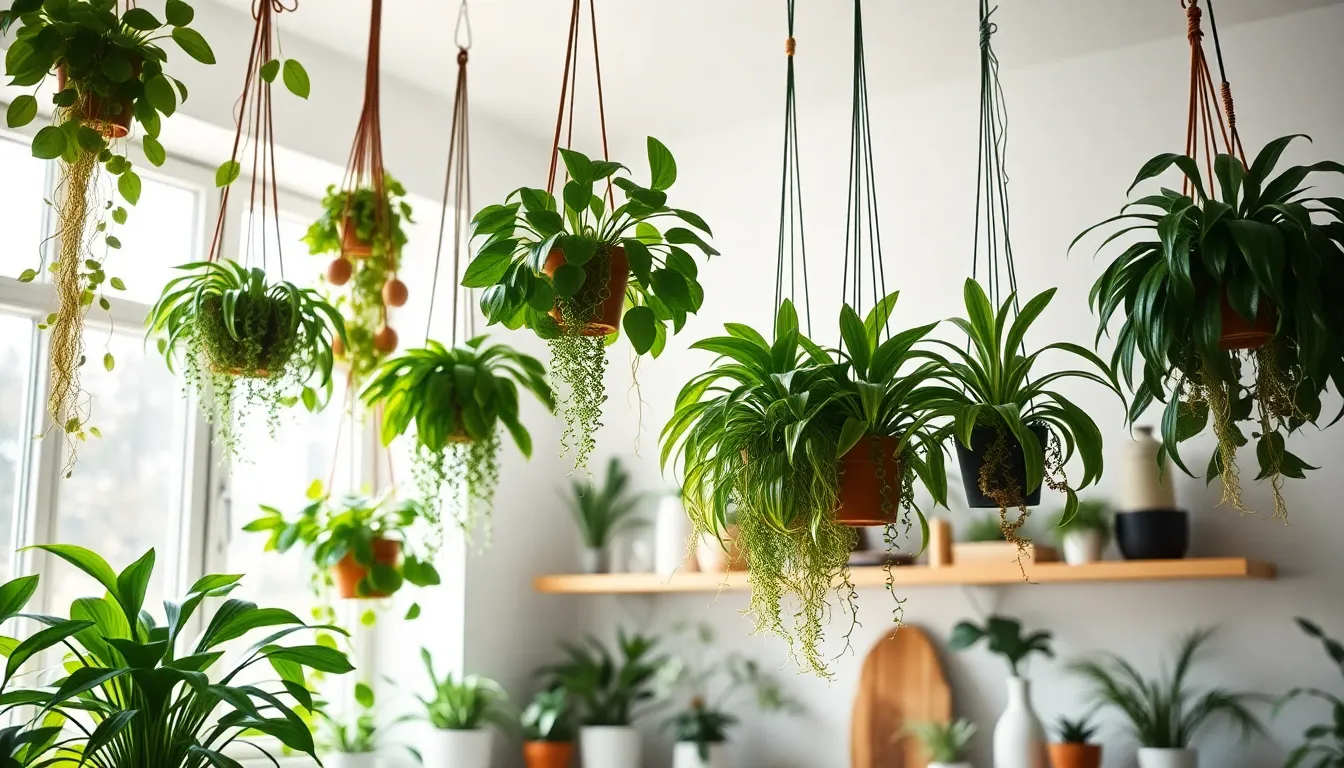
Even experienced gardeners can make crucial errors when bringing their green thumb to the kitchen. We’ll help you sidestep these common pitfalls to ensure your hanging plants thrive while maintaining a safe and functional cooking space.
Overcrowding and Spacing Issues
Crowding too many plants together creates a breeding ground for problems that can quickly spread throughout your kitchen garden. Plants need adequate space to receive proper air circulation, which prevents mold growth and pest infestations that flourish in stagnant conditions.
Spacing each plant appropriately ensures they receive sufficient light and airflow for optimal health. We recommend leaving at least 12-18 inches between hanging planters to allow proper ventilation and prevent competition for resources.
Vertical spacing techniques maximize your kitchen’s potential without creating a cluttered appearance. Hang plants at different heights to create an appealing layered effect while ensuring each plant has room to grow and spread naturally.
Heat and Steam Considerations
Kitchen environments present unique challenges with their fluctuating temperatures and steam from daily cooking activities. Choose resilient plants like pothos or spider plants that naturally tolerate humidity and occasional heat exposure without suffering damage.
Heat source proximity can quickly kill even the hardiest plants if you’re not careful about placement. Keep hanging plants at least 3 feet away from stoves, ovens, and heat vents to prevent foliage damage and soil dehydration.
Ventilation positioning helps your plants thrive in steamy conditions while preventing fungal growth. Place hanging plants where they receive indirect light and gentle air movement, avoiding areas where steam accumulates heavily during cooking sessions.
Safety and Accessibility Concerns
Secure mounting systems prevent dangerous accidents that could injure family members or damage your kitchen. Install ceiling hooks or wall mounts rated for at least twice your planter’s total weight, including soil and water.
Height considerations ensure your hanging plants don’t interfere with daily kitchen activities or create hazardous situations. Position planters where they won’t cause head bumps or risk being knocked over during meal preparation.
Maintenance accessibility affects your long term success with kitchen hanging plants. Choose locations where you can safely reach plants for watering, pruning, and general care without needing ladders or precarious stretching that could lead to falls.
Create Functional Plant Arrangements
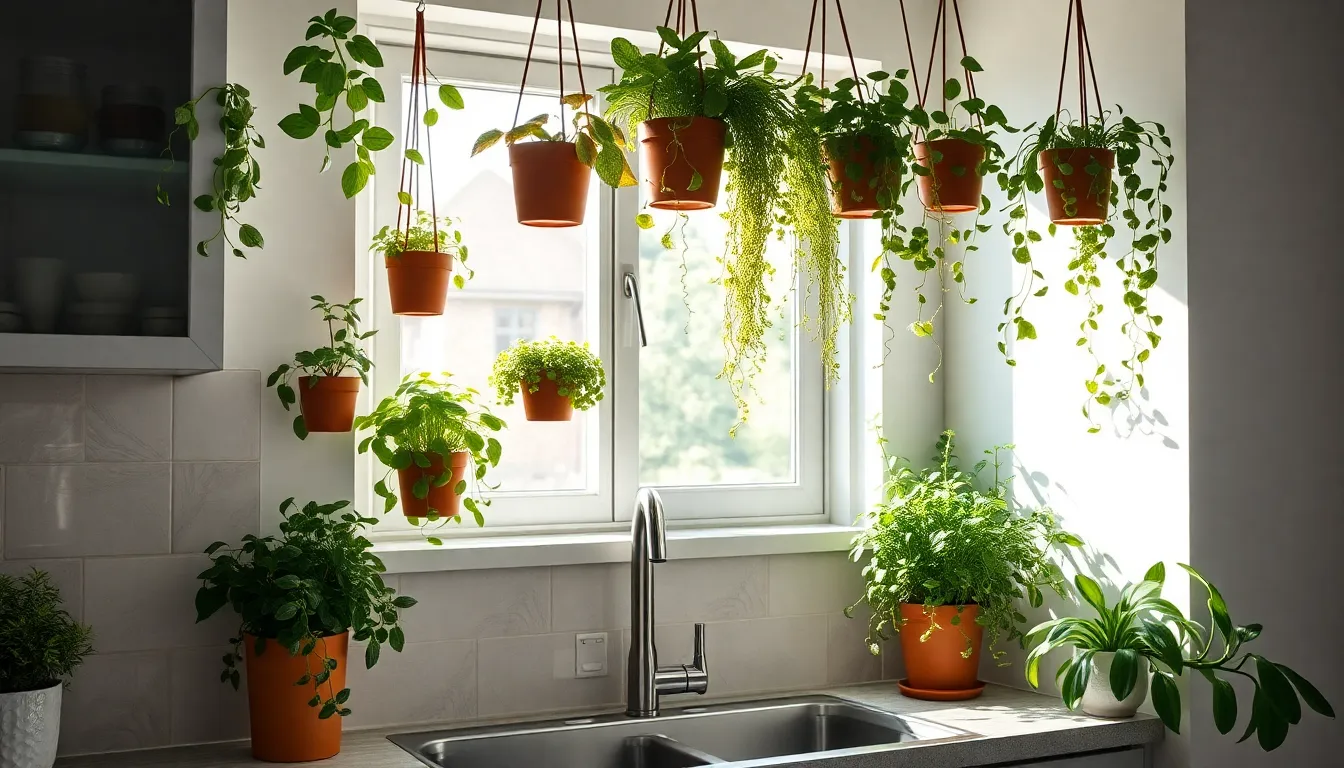
We’ve covered the basics of selection and placement, so now let’s explore how to create purposeful arrangements that transform our kitchens into functional green spaces. Smart organization maximizes both visual impact and practical benefits while keeping our culinary workspace efficient.
Herb Gardens for Cooking
Culinary herbs deserve prime real estate in our hanging arrangements since they provide fresh ingredients literally within arm’s reach. We can suspend small pots or hanging planters containing thyme, marjoram, and other cooking essentials above kitchen islands or near prep areas. Thyme stands out as an exceptional choice because it offers antibacterial properties while being remarkably easy to grow indoors, making it perfect for kitchen environments.
Grouping herbs with varying heights creates attractive layered displays that add depth to our kitchen design. We should position faster growing herbs like basil in larger containers while placing slower growing varieties like rosemary in smaller pots to maintain visual balance. Fresh herbs thrive in kitchen conditions and eliminate the need for dried alternatives, giving us superior flavor profiles in our cooking.
Air-Purifying Plant Combinations
Strategic combinations of air purifying plants work through phytoremediation to filter toxins like formaldehyde, benzene, and carbon monoxide from our kitchen atmosphere. We can create powerful purification systems by mixing different plant types that target various pollutants commonly found in cooking spaces. Kitchen environments naturally produce fumes from cooking, cleaning products, and household chemicals that these plant combinations effectively neutralize.
Combining trailing varieties with upright growth forms maximizes our air cleaning coverage while creating visually interesting arrangements. We should space these combinations throughout different areas of our kitchen to ensure comprehensive air filtration. Multiple air purifying plants working together create healthier kitchen atmospheres than single specimens, making our cooking spaces more comfortable and breathable.
Seasonal Rotation Systems
Rotating our hanging plants seasonally maintains both plant health and kitchen aesthetics throughout the year while ensuring optimal growing conditions. We can swap warm weather herbs with hardier plants or air plants during cooler months to match changing light and temperature conditions. This systematic approach keeps our arrangements fresh and prevents plants from declining due to seasonal environmental shifts.
Planning rotations around our cooking patterns helps us maintain year round functionality in our herb selections. We should prepare backup plants during transition periods to avoid gaps in our hanging displays. Seasonal rotation also refreshes the visual interest of our kitchen spaces, giving us opportunities to experiment with different plant combinations and discover new favorites for our culinary adventures.
Conclusion
We’ve shown you how hanging plants can transform your kitchen into a vibrant and functional space that’s both beautiful and practical. From selecting the right low-light varieties to mastering proper placement and installation techniques you now have all the tools needed to create your perfect green kitchen oasis.
Remember that success lies in understanding your kitchen’s unique conditions and choosing plants that’ll thrive in your exact environment. Whether you’re working with a compact galley kitchen or a spacious open-concept design the principles we’ve outlined will help you maximize both style and functionality.
Your kitchen hanging garden awaits – it’s time to bring life and freshness to the heart of your home while enjoying cleaner air and easy access to fresh herbs for your culinary adventures.
Frequently Asked Questions
What are the main benefits of having hanging plants in the kitchen?
Hanging plants in the kitchen maximize vertical space while providing aesthetic appeal and practical advantages. They improve air quality by filtering toxins, create visual interest without taking up counter space, and can provide fresh herbs for cooking. They’re perfect for both small and large kitchens, transforming unused areas into vibrant focal points.
Which plants work best in low-light kitchen conditions?
Low-light tolerant plants like pothos, ZZ plants, and snake plants are ideal for kitchens with limited natural light. These varieties thrive in dimmer conditions while still providing air-purifying benefits. They’re also low-maintenance, making them perfect for busy home cooks who want greenery without intensive care requirements.
Where should I place hanging plants in my kitchen for maximum impact?
Position plants near windows for adequate sunlight, above kitchen islands for dramatic displays, and in corner spaces or empty walls. Ensure placement doesn’t interfere with cooking activities or safety. Strategic positioning near heat sources should be avoided, and plants should be easily accessible for maintenance and watering.
What type of hanging hardware should I use for kitchen plants?
Use ceiling hooks for heavy plants with proper weight capacity, wall-mounted brackets for eye-level displays, or tension rods for renters. Ensure all mounting systems are securely installed and can support the plant’s weight when fully watered. Consider the kitchen’s humidity and heat when selecting materials.
How often should I water hanging plants in the kitchen?
Check soil moisture regularly and water when the top inch feels dry. Kitchen humidity can affect watering frequency, so monitor plants closely. Ensure pots have proper drainage to prevent root rot. Most hanging plants need watering 1-2 times per week, but this varies based on plant type and kitchen conditions.
Can I grow herbs in hanging planters in my kitchen?
Yes, herbs like thyme, marjoram, and compact varieties work excellently in hanging planters. Position them in easily accessible locations for cooking convenience. Group herbs of varying heights for visual appeal and ensure they receive adequate light. Fresh herbs in the kitchen provide both culinary benefits and natural fragrance.
What common mistakes should I avoid with kitchen hanging plants?
Avoid overcrowding plants (maintain 12-18 inches spacing), placing them too close to heat sources, and choosing plants unsuitable for kitchen conditions. Don’t neglect proper drainage or ignore regular maintenance. Ensure secure mounting to prevent accidents and consider the kitchen’s humidity and temperature fluctuations when selecting plants.
Do I need special lighting for hanging plants in the kitchen?
Assess your kitchen’s natural light first. If insufficient, supplement with LED grow lights positioned at proper distances to prevent leaf burn. Rotate plants regularly for even growth, especially in areas with limited light access. Many kitchen plants adapt well to artificial lighting when natural light is inadequate.

